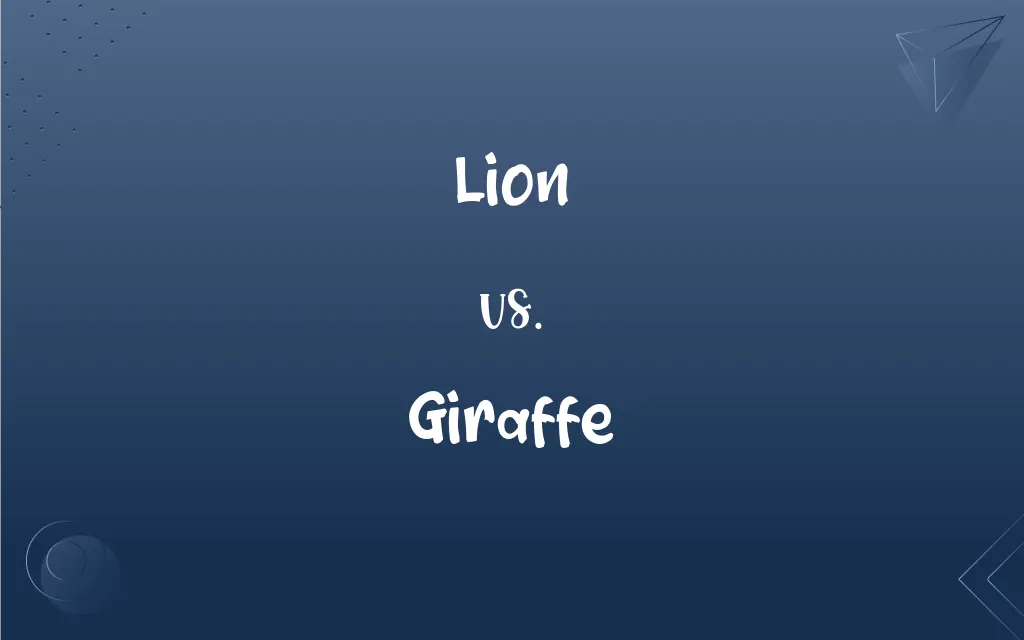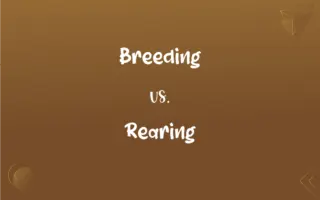Lion vs. Giraffe: What's the Difference?
By Aimie Carlson & Janet White || Updated on May 23, 2024
A lion is a large, carnivorous feline known for its strength and social structure, while a giraffe is a tall, herbivorous mammal recognized for its long neck and legs.

Key Differences
A lion is a powerful carnivore, part of the big cat family, known for its muscular build, strength, and social behavior. Lions live in groups called prides, which consist of related females, their offspring, and a few adult males. This social structure is unique among big cats and aids in hunting and raising cubs. In contrast, a giraffe is a herbivore distinguished by its exceptionally long neck and legs, enabling it to reach high foliage in trees for feeding. Giraffes are typically solitary or form loose herds without the complex social structure seen in lions.
Lions primarily inhabit savannas, grasslands, and open woodlands where they can hunt large prey such as zebras, wildebeests, and antelopes. Their hunting strategy relies on cooperation within the pride, with females typically taking the lead. On the other hand, giraffes are native to African savannas and open woodlands as well but feed mainly on acacia trees and other high vegetation. Their height provides a significant advantage in spotting predators from a distance and accessing food sources out of reach for other herbivores.
In terms of physical appearance, lions are robust animals with a tawny coat, males having a distinctive mane that varies in color. This mane not only provides protection during fights but also plays a role in mating displays. Giraffes, however, are easily recognizable by their long necks, spotted coats, and horn-like ossicones on their heads. The spots provide camouflage, while the long necks are used in a behavior known as "necking" during fights between males for dominance and mating rights.
Lions communicate through a range of vocalizations, including roars that can be heard up to five miles away, establishing territory and social bonds. Giraffes are generally quieter but do communicate through sounds like grunts, snorts, and occasionally humming at night. They also use body language, such as neck postures and leg movements, to communicate with each other.
Both animals face conservation challenges due to habitat loss, human-wildlife conflict, and poaching. Lions are classified as vulnerable by the IUCN, with their populations declining. Giraffes are also listed as vulnerable, with some subspecies critically endangered. Conservation efforts for both species involve habitat protection, anti-poaching measures, and breeding programs.
ADVERTISEMENT
Comparison Chart
Diet
Carnivorous
Herbivorous
Social Structure
Lives in prides
Solitary or loose herds
Habitat
Savannas, grasslands, woodlands
Savannas, open woodlands
Physical Appearance
Tawny coat, males have a mane
Long neck, spotted coat, ossicones
Communication
Roars, grunts, body language
Grunts, snorts, humming, body language
ADVERTISEMENT
Lion and Giraffe Definitions
Lion
A large, carnivorous feline known for its strength and social behavior.
The lion roared loudly, asserting its dominance over the territory.
Giraffe
A tall herbivorous mammal known for its long neck and legs.
The giraffe gracefully reached up to nibble leaves from the tall tree.
Lion
A powerful predator with males featuring a distinctive mane.
The male lion's mane was dark and thick, indicating maturity.
Giraffe
A species distinguished by its spotted coat and horn-like ossicones.
The giraffe's unique pattern helps it blend into the dappled light of the savanna.
Lion
A social animal that uses roars to communicate and establish territory.
The lion's roar echoed across the savanna, warning rivals to stay away.
Giraffe
A generally solitary animal that communicates through subtle sounds and body language.
The giraffe made a low humming sound at night, communicating with others in its group.
Lion
A big cat species living in prides within African savannas and grasslands.
The pride of lions worked together to hunt a zebra.
Giraffe
An African mammal feeding primarily on high foliage.
Giraffes are often seen browsing the tops of acacia trees.
Lion
An apex predator that preys on large herbivores.
Lions rely on their speed and strength to capture their prey.
Giraffe
A herbivore that uses its height to spot predators from afar.
The giraffe's height allows it to keep a lookout for approaching lions.
Lion
A large carnivorous feline mammal (Panthera leo) of Africa and northwest India, having a short tawny coat, a tufted tail, and, in the male, a heavy mane around the neck and shoulders.
Giraffe
An African ruminant mammal (Giraffa camelopardalis) having a very long neck and legs, a tan coat with orange-brown to black blotches, and short horns. It is the tallest land animal, often reaching a height of 5 meters (16 feet).
Lion
A mountain lion.
Giraffe
A ruminant, of the genus Giraffa, of the African savannah with long legs and highly elongated neck, which make it the tallest living animal; yellow fur patterned with dark spots, often in the form of a network; and two or more short, skin-covered horns, so-called; strictly speaking the horn-like projections are ossicones.
Lion
A very brave person.
Giraffe
A giraffe unicycle.
Lion
A person regarded as fierce or savage.
Giraffe
(Cockney rhyming slang) A laugh.
Are you having a giraffe?!
Lion
A noted person; a celebrity
A literary lion.
Giraffe
A very tall individual.
Lion
Lion See Leo.
Giraffe
An African ruminant (Giraffa camelopardalis formerly Camelopardalis giraffa) related to the deers and antelopes, but placed in a family (Giraffidae) by itself; the camelopard. It is the tallest of quadriped animals, being sometimes twenty feet from the hoofs to the top of the head. Its neck is very long, and its fore legs are much longer than its hind legs. There are three types, having different patterns of spots on the pelt and different territories: the Reticulated Giraffe, the Masai Giraffe, and the Uganda Giraffe. Intermediate crosses are also observed.
Lion
A big cat, Panthera leo, native to Africa, India and formerly much of Europe.
Tigers and lions share a common ancestor from a few million years ago.
Giraffe
Tallest living quadruped; having a spotted coat and small horns and very long neck and legs; of savannahs of tropical Africa
Lion
(in particular) A male lion, as opposed to a lioness.
Lion
(by extension) Any of various extant and extinct big cats, especially the mountain lion.
Lion
A Chinese foo dog.
Lion
An individual who shows strength and courage, attributes associated with the lion.
Lion
A famous person regarded with interest and curiosity.
Lion
A light brown color that resembles the fur of a lion. en
Lion
(historical) An old Scottish coin, with a lion on the obverse, worth 74 shillings.
Lion
Of the light brown color that resembles the fur of a lion.
Lion
A large carnivorous feline mammal (Panthera leo, formerly Felis leo), found in Southern Asia and in most parts of Africa, distinct varieties occurring in the different countries. The adult male, in most varieties, has a thick mane of long shaggy hair that adds to his apparent size, which is less than that of the largest tigers. The length, however, is sometimes eleven feet to the base of the tail. The color is a tawny yellow or yellowish brown; the mane is darker, and the terminal tuft of the tail is black. In one variety, called the maneless lion, the male has only a slight mane.
Lion
A sign and a constellation; Leo.
Lion
An object of interest and curiosity, especially a person who is so regarded; as, he was quite a lion in London at that time.
Such society was far more enjoyable than that of Edinburgh, for here he was not a lion, but a man.
Lion
Large gregarious predatory feline of Africa and India having a tawny coat with a shaggy mane in the male
Lion
A celebrity who is lionized (much sought after)
Lion
(astrology) a person who is born while the sun is in Leo
Lion
The fifth sign of the zodiac; the sun is in this sign from about July 23 to August 22
FAQs
What do giraffes eat?
Giraffes are herbivorous and mainly feed on the leaves of tall trees, particularly acacia trees.
How do lions communicate?
Lions communicate through vocalizations like roars, grunts, and body language.
What do lions eat?
Lions are carnivorous and primarily eat large herbivores like zebras, wildebeests, and antelopes.
What is a distinctive feature of male lions?
Male lions have a mane, which varies in color and size and plays a role in protection and mating displays.
What is a distinctive feature of giraffes?
Giraffes have exceptionally long necks and legs, spotted coats, and horn-like ossicones on their heads.
How do giraffes live?
Giraffes are generally solitary or form loose herds without a strict social structure.
What is the conservation status of giraffes?
Giraffes are also listed as vulnerable, with some subspecies critically endangered.
How do lions live?
Lions live in social groups called prides, consisting of related females, their offspring, and a few adult males.
Where are giraffes found?
Giraffes are found in African savannas and open woodlands.
Where are lions found?
Lions inhabit savannas, grasslands, and open woodlands across Africa.
How do giraffes communicate?
Giraffes communicate through sounds like grunts, snorts, humming at night, and body language.
How do lions hunt?
Lions hunt cooperatively within their pride, using stealth and teamwork to capture prey.
How long do giraffes live?
Giraffes usually live around 25 years in the wild and up to 30 years in captivity.
What role does a lion’s mane play?
A lion’s mane provides protection during fights and serves as a visual indicator of maturity and health.
What is the conservation status of lions?
Lions are classified as vulnerable by the IUCN due to declining populations.
Why do giraffes have long necks?
Giraffes have long necks to reach high foliage and for males to engage in necking fights for dominance.
Are lions endangered?
Lions are not currently endangered but are considered vulnerable with decreasing numbers.
Are giraffes endangered?
Giraffes are considered vulnerable, with certain subspecies facing critical endangerment.
How long do lions live?
In the wild, lions typically live around 10-14 years, while in captivity, they can live over 20 years.
How do giraffes defend themselves?
Giraffes defend themselves with powerful kicks and by using their height to spot predators early.
About Author
Written by
Aimie CarlsonAimie Carlson, holding a master's degree in English literature, is a fervent English language enthusiast. She lends her writing talents to Difference Wiki, a prominent website that specializes in comparisons, offering readers insightful analyses that both captivate and inform.
Co-written by
Janet WhiteJanet White has been an esteemed writer and blogger for Difference Wiki. Holding a Master's degree in Science and Medical Journalism from the prestigious Boston University, she has consistently demonstrated her expertise and passion for her field. When she's not immersed in her work, Janet relishes her time exercising, delving into a good book, and cherishing moments with friends and family.
































































